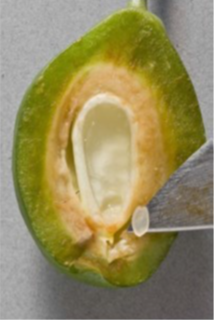Will you need to thin prunes this year? In order to keep fruit from falling through the sizer, you need to do some legwork and estimate your fruit set. If needed, thinning should occur roughly around the same time as ‘reference date’, or the point at which 80-90% of the fruit have a visible endosperm. The endosperm, a clear gel-like glob, will be found in the seed on the blossom end of the prune (Figure 1) and is solid enough to be removed with a knife point. Typically, the reference date occurs in late April or early May, approximately one week after the pit tip begins to harden. The earlier the thinning is done, the greater effect it will have on final fruit size at harvest, though if you thin too early, you may damage the trees without removing the desired number of fruit.
To decide whether to thin, estimate the number of fruit per tree to produce your desired crop, determine the number of fruit on a few (3) representative trees, at or just before reference date, and, using those numbers, decide if you need to thin. Calculate how much fruit needs to come off if thinning is needed. Finally, shake if thinning is needed. Below I walk through the math, step by step.
Want to skip the hand calculations? Check out the online thinning calculator.
- Estimate the targeted tonnage from a given block by considering orchard history, age, etc. Let’s assume a target of 4 tons/ac, and shoot for 60 dry count/lb. From there, we calculate a targeted number of fruit per tree:
(Dry pounds per ac x Dry count per lb) ÷ Trees per ac = Target number fruit per tree
- Determine the actual number of fruit in a sample tree and compare that number to the target of 3,200 fruit. Ideally, you would repeat this procedure on 3 trees, representative of most trees in the orchard, to ensure accuracy. Place a tarp under the tree and mechanically shake off as much fruit as possible, then hand strip any remaining fruit. Collect all the sound fruit from the tarp and weigh them (for easy math, let’s assume right now it weighs 100 lbs). Take a 1-lb subsample of the fruit and count how many sound fruit are in a pound (here, we’ll assume 90 fruit/lb). Don’t count fruit that looks like it wouldn’t have stayed on the tree (if you hadn’t have stripped it off). These fruit are light green or otherwise look slightly “off” compared to the strong fruit that will make it to harvest. Then use those numbers to determine the total number of fruit per tree:
Total tree fruit weight x Number of prunes per lb = Total number of fruit per tree
- Decide if you need to thin. Subtract the number of fruit needed at harvest from the number of fruit on the tree now (at reference date). In this example, you have approximately 2.8 times the number of fruit on the tree as desired to hit the target of 60 dry count/lb, and you may consider thinning the orchard. You don’t want to simply remove all those fruit though, because you need to account for natural fruit drop and variability in fruit per tree across the orchard. Estimates of natural fruit drop range from 10%-40%. This is an area where you need to account for orchard history, as well as your own risk threshold. Many growers prefer to leave approximately 50% more fruit on the tree than the target amount. This means that we need 50% more fruit on the tree after mechanical thinning than we want remaining on the tree at harvest:
Target number prunes per tree x (1.5% fruit drop buffer) = Adjusted number fruit per tree
- Calculate how many fruit to remove by subtracting the adjusted target number from the actual number of prunes on the tree:
Actual fruit per tree – Adjusted target fruit per tree = Number fruit to remove
- Shake (if needed). Use harvest machinery (shaker) to remove the approximately 4,200 excess fruit. Shake a tree for one second, and following the steps above, calculate how many fruit were removed. If needed, increase the shaking time until the desired numbers are removed. Typical shaking time is 2-4 seconds; avoid shaking for longer than 6-7 seconds to prevent unnecessary damage. Once you’ve calibrated your shaking time, go through and thin the block. If you are thinning for more than a week, check fruit per tree and green fruit per pound every few days to make sure that your shake time doesn’t need to be adjusted down as fruit grow.






Leave a Reply